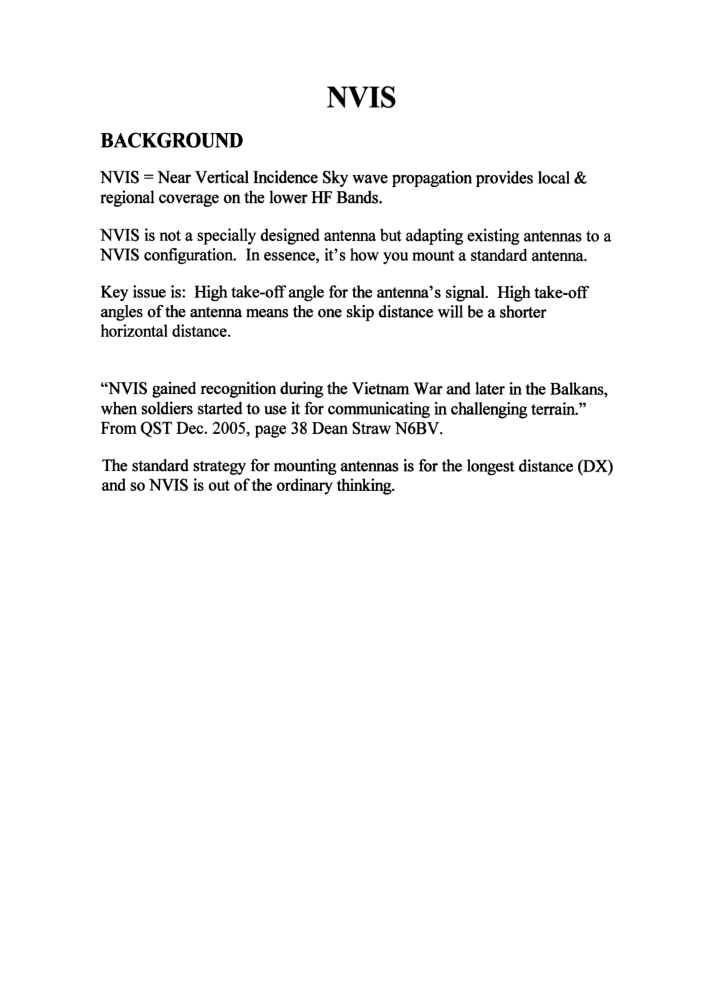



BACKGROUND NVIS = Near Vertical Incidence Sky wave propagation provides local & regional coverage on the lower HF Bands. NVIS is not a specially designed antenna but adapting existing antennas to a NVIS configuration. In essence, it's how you mount a standard antenna. Key issue is: High take-off angle for the antenna's signal. High take-off angles of the antenna means the one skip distance will be a shorter horizontal distance. "NVIS gained recognition during the Vietnam War and later in the Balkans, when soldiers started to use it for communicating in challenging terrain." From QST Dec. 2005, page 38 Dean Straw N6BV. The standard strategy for mounting antennas is for the longest distance (DX) and so NVIS is out of the ordinary thinking.
WHY USE NVIS? To connect with localized stations from about 1 mile to 300 miles out. Note: Ground waves are typically good for less than 25 miles out depending on what is in between the two stations. Area Hunters and Fishermen have a difficult time calling home. It is too far from home for 2 meters and too short for HF . [J Or, there is a mountain between the two antennas (camp & Home) [J NVIS nearly vertical propagation means its penetration of the high absorption D - layer is a millimal distance and therefore minjrnallosses. This is as apposed to a 30 degree penetration or long diagonal penetration. NVIS antenna configurations, horizontally polarized and mounted low to the ground, has less noise (SNR).
NVIS ANTENNA CONFIGURATIONS Horizontally polarized dipoles, long wires, etc. are the easiest to mount low to the ground and therefore have high take-off angles. Screw Driver/Ham Sticks/Typical Verticals must be mounted in some kind of a horizontal configuration or they are a poor NVIS antenna because of their low take-off angle. Mount inverted "V" dipoles (80/40M) about 20 feet above the ground with the ends about 8 feet above the ground for safety*. Mount flat top dipoles (80/40M) about 10- 5 feet above the ground*. Horizontal antennas mounted lower than 10 feet above the ground* will work but the earth starts absorbing part of your signal. Antenna efficiency starts to diminish. SNR isn't reduced enough to offset the loss in efficiencies. NEC software plots showed that at ten feet, the radiation pattern closely resembled a round ball sliced in half. Typically use 80 meters at night. Typically use 40 meters during daylight hours, * Protect people from low mounted antennas from RF bums durin~ transmittin~.
EZIlEC .oce . . . . ) c /::";. 1, \l~~!. :... ~..:.t:~:~~~::~.. 375MHz Elevsoo Plot Cursor Elev 25.0 deg AzmJih ~ 0.0 ~. Gain 7.92 dBi ()Jter ~ 7 .92cI:Ii 0.0 (ftnax 3D Max Gain 7 .92 ~ Angle = Slice Max Gai} 792 ~i @ Elev 25.0 deg Beamwidth 31.0 deg; .3c13 @ 13.3,44.3 deg- S~Gai1 7.92cB@~~=155.0deg. FrontJSM:lekile 0.0 113 gO me.+o- ~ wa.ve. <lIfO/e.. ':351«1- 0 T ~ wav.. ~ b"v.. t6a , '#find N ~ IS A fAWI.f,h ND't 0. G~ n-ft ",,0.
EZt£C ...: 375t.1-iz ElevSKJn ~ Cl.rsor Bey ~.O deg ~ 6.1818 Az~~ O.O~. ~ RI"Ig 6. 16c1:1i 0.0 c8nex 3OMex()8, 6.18cB $Ice ~ ~ 6.1818@Be",An!je.9:1.0deg ~ 100.0 cleg.; -3<13 @ 370, 143.0 cIeg. SkiI*)tIe G8"I c -1 00 cD F~ -100ce gOmlt~... .1;: WA"f. d,PJe @ 3' f4.f;'t
"... "'..t A-""'/ ~~ eo -~ "8t.e~ 18u'-t.-t Wh8 '" 40~5ft.1t~ '"'-.. " - ~ c.. ~) NVl5 ~... An"tenna Drwing bJ' KC7REA'
NVIS REFERENCE MATERIALS www.co.missoula.mt.us/acs/acs/prop.htm Q www.wOipl.com/ecom/nvis/nvis.htm Q ARRL 's web page and search NVIS Antennas Q Google Search "NVIS Antennas (J Etc., Etc. Q
Recommend
More recommend